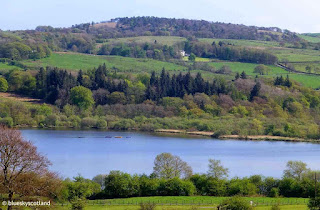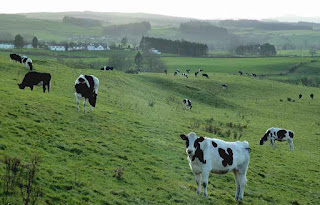ALL PHOTOS CLICK FULL SCREEN.
Ben Lomond in winter from Kilmacolm. It's been years since either Alan or myself visited Kilmacolm and the nearby Knapps Loch and Glen Moss. This is good however as it stops any over-familiarity with this area creeping in. I always take loads of photographs in this part of Inverclyde and Renfrewshire. Regional boundaries have changed here over time but in my own head I've always ignored these official lines. I separate them instead by landscapes and geology. Renfrewshire is my wonderland and although Kilmacolm and Knapps Loch reside just over the boundary line in Inverclyde my own visual boundary lines when cycling or walking here place them firmly in 'green-hill country.' Glen Moss however is in Renfrewshire, despite being a very short distance from Kilmacolm so official boundary lines, for me, are largely unimportant. Dozens of quiet minor roads crisscross green-hill country through rolling farmland. Inland Inverclyde tends to be high bleak moor, hill farms and only a few minor roads. You can easily tell the difference walking or cycling.
Castle Semple Loch. This is what green-hill country looks like to me. In the past when walking or cycling I'm not that aware of official boundary markers between different districts... or when I'm crossing them. That's only important if you live here... for letter delivery, postcodes, public services etc...I have always separated them by landscape features instead. Rolling green hills, inland lochs and dams, cattle, farms... rural life. Picture box perfect.
To me, visually, this is always green-hill country. A beautiful oasis. I'm not that bothered if it's in Renfrewshire, North Ayrshire or Inverclyde as it's clearly defined for me just by looking at it.
So for me this is green-hill country with Inverclyde the much higher slopes behind. It's probably all Inverclyde officially but as a traveller and not a resident I don't care about that. I've known all my life visiting 'the kingdom' where my country begins and ends.
It can be quite spectacular, as here at Auchenbothie with the River Clyde deep water trench hidden and a backdrop of the Kilpatrick Escarpment.
But in general it's usually very obvious where my own boundary lines are without looking at a map. Green-hill Country sums it up.
So we, Alan and I, started off at Kilmacolm and Knapps Loch. It does feel like a magical kingdom but like the English Lake District wealth is often the key. Kilmacolm, like Helensburgh and Rhu, is one of Scotland's richest communities so the scenery has been enhanced by that revenue stream for over one hundred years.
In less well heeled lower middle class areas I've been really bored on walks, street after street of perfectly decent but very dull identikit housing that I never even bothered to post but never that here. I find I either like rough housing schemes/ or very wealthy areas just because they are much more interesting architecturally to walk around. Beautiful church above. In some ways 'green-hill country' feels very 'English home counties' and you can't say that for much of urban Scotland.
So we did our usual tour of Knapps Loch, seen here...
... then up onto the obvious crag behind the loch...reached via grassy paths, although they are getting more used looking now with increased yearly rainfall in west Scotland and post pandemic healthy living daily advice to get outdoors, influencing suddenly exercise conscious adults... plus the usual internet obsession with beauty spots worldwide. Glen Moss incidentally is reached across the fields on faint paths via the houses in the middle top of photo and a signposted wooded strip/path through the golf course.
It's a popular dog walking area for locals which is no surprise as I've always found in other upmarket areas they build golf courses on any available land rather than public parks although Kilmacolm is better served with good walks locally than say Newton Mearns or Helensburgh.... with far less scenic minor roads available in the last two places mentioned. But you've got to know where to go in this area. Visitor parking is very limited ... which is a good thing throughout Green-hill Country/ Renfrewshire/Inverclyde/North Ayrshire as it keeps it fairly quiet.
A kestrel on a tree... snapped unaware as balancing on this thin twig was occupying it fully in a playful breeze. Does my bum look big in this?
Minutes later it spotted a potential meal, a mouse or a vole, and soared upwards to maintain its classic hovering position.
On other occasions it can seem like a magical place. A few geese in a field here.
Happy geese feeding near Kilmacolm.
And some amazing buildings. Mount Zion in Quarriers Village, above.
The village lands.
Old signpost near Glen Moss.
Glen Moss. It used to be used for curling in winter but with warmer temperatures and a lack of marshlands UK wide it's now best suited as a wildlife reserve.
Kilbarchan Steeple.
Howwood and the surrounding green-hill country.
Kilmacolm church and local bus.
And if you fancy something different the Clyde Coast is just a short drive/ cycle ride or local bus away.
I read recently about the Cathkin Braes being the best place to view the City of Glasgow from... as a perfect high vantage point in a quality newspaper. That's a matter of personal taste of course but to my mind, having visited both areas recently and in the past it's very obviously not. The next post should confirm that beyond doubt.... coming as it does from Central Belt Scotland's best living landscape photographer :) ie. me.
A very different land in this link. I've been a fan of this duo for over ten years. Clicking unmute brings the sound on.

























5 comments:
Why is it called 'Quarriers Village'? was it built for quarry workers or suchlike?
And the Lake District isn't a 'rich area' - too many farmers for it to be a rich area - most of the rest of us haven't got much either!
My mother came from Kilmacolm. In the picture of the church and bus if you went up to the right you would find the site of her long demolished home at Low Shells, next to the “wee park”. I think the sale sign just peeking in on the left is the Cross Cafe where she knew the family well. Her grandparents lived in the Bridgend Toll House, also long gone, by the war memorial. Her childhood memories were always idyllic despite the obvious poverty.
Hi Carol. I did a post on Quarriers Village a while ago, which you read and commented on.
It was a purpose built children's home for orphans and street children from Greenock, Port Glasgow etc. Some of the houses are now privately owned but there's still social work buildings there for referred patients, adult or otherwise.
Everyone in my hill-walking club, even the blind members, noted how affluent the scenic central Lake District was (i.e. the National Park area ) compared to towns on the less scenic outskirts like Whitehaven, Workington and Barrow in Furness, all on the coast, which did look much poorer. I'm sure some people are poor in the hill walking, scenic village /tourist zones but the number of million pound properties all over the popular central area when you go walking would suggest that a dire lack of money is not that much of an issue there.
Hi Anabel. I was going to mention there's probably some poor types living in the original cottage houses and flats of Kilmacolm village on pensions or unemployment benefits and maybe even a local branch of the ubiquitous food bank that's one of the biggest growth industries in the UK after decades of austerity but I wanted to keep any politics out of it and just focus on the good stuff instead... for a change. Like the central Lake District the overall impression of Kilmacolm that I always get is that it's a very affluent area in the main. But maybe I'm completely wrong?
Here comes "The Best landscape photographer in central belt Scotland" is what a fellow hill-walker used to say whenever I arrived but it was not complementary... more sarcastic tongue in cheek banter due to my obvious photography obsession, even back then.
No, it was rich in her day too but obviously there were less well off people to do the menial jobs. When she left school mum went to work in the bank and was amazed at the kind of people she met, none of her family ever having had any need of a bank. Her friend’s father was chauffeur to a local bigwig and moved with them when they went to Auchterarder.
Post a Comment